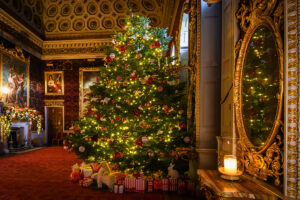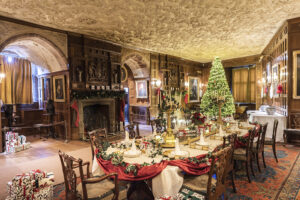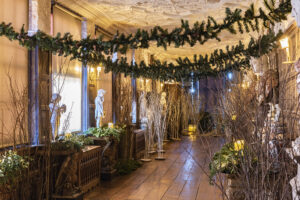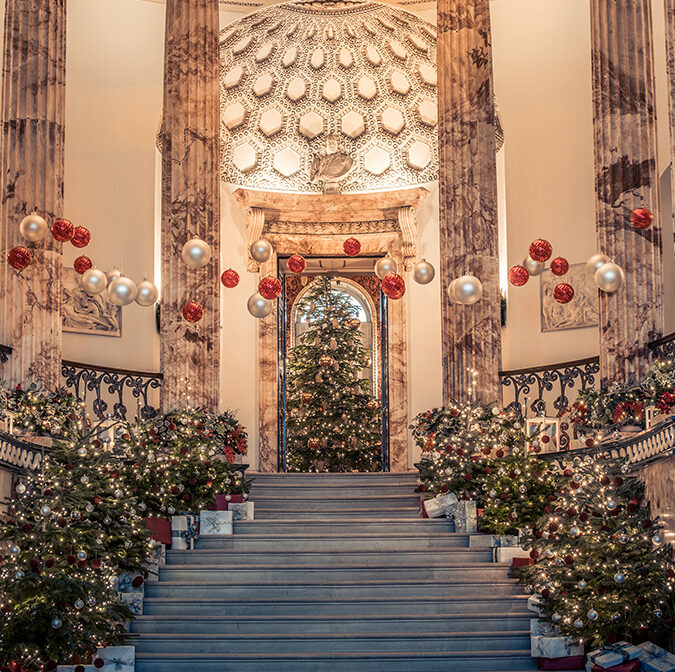There’s nowhere better to soak up the atmosphere of Yuletides than in a stately home decorated for Christmas…
Here are Britain’s best stately homes at Christmas…
Stately homes at Christmas: in the past
That festive scene in every historical drama: our hero and heroine enjoying Christmas celebrations at the Big House: feasting, dancing, a sparkling tree, presents for everyone and Blind-Man’s Bluff. How true is the fantasy? As with anything historical, it depends. Christmas has swung in and out of fashion with the British gentry, but regular folk have never forgotten how to celebrate.
The winter solstice (21 December) was important enough for ancient people to align great monuments like Stonehenge with the sunset. The Romans celebrated Saturn, god of agriculture and plenty, at the raucous winter festival of Saturnalia, and feasting gave country people an excuse to eat the meat of any animals that would not survive a long winter. There was little work to do in frozen fields so labourers could take a well-earned rest and let off steam with games and merrymaking.

The early Church did not want such pagan-influenced traditions to continue but knowing there would be riots if they stopped the fun, turned the celebrations towards Christianity, designating a midwinter ‘Christ Mass’ to mark the birth of Christ. It was mainly a religious affair, but workers needed rest after the long harvest, so Christmas became a twelve-day festival, ending with boisterous fun and games on Twelfth Night. Medieval halls hung evergreen decorations and ‘kissing boughs’ of greenery, fruits and, later, mistletoe, quietly forgetting any pagan roots.
Henry VIII was a huge fan of Christmas, dancing, feasting, and decorating his castles for the full twelve days. His daughter Elizabeth celebrated no less joyfully and the great Tudor houses of England followed her lead, inviting travelling players, musicians and storytellers to entertain their guests.
The best stately homes at Christmas 2022
Packwood House
Packwood House in Warwickshire will be delving into its Elizabethan past for this year’s decorations. Each room will be decorated differently, down the ages to the present day. In the 1930s, Packwood’s last owner, Graham Baron Ash, started celebrating ‘Tudor’ Christmas again. The family visitor’s book proves that Packwood was ‘Open House’ at Christmastime, and Ash even burned a traditional Yule Log in his ‘Great Hall’, created from a derelict barn.
Dyrham Park
Christmas suffered a severe setback during the Commonwealth (1649-1660), following the execution of Charles I, when Puritan laws forbade any kind of fun. It would take a couple of hundred years for the festival to recover. At Dyrham Park near Bristol, the focus of celebrations are on the wedding of William Blathwayt and Mary Wynter that took place after the Restoration of Charles II, at Christmas 1686. The house will be decorated with evergreens to recall both celebrations.
Christmas Day still very much focused on church services, though the end of the twelve-day period saw an opportunity for estate owners to hold parties for their tenants. They presented ‘Christmas boxes’ (tips) to apprentices, servants, tradesmen and the poor. The gentry themselves, however, found Christmas rather ‘common’ and celebrated less, preferring small parties for friends, recitals, a little carol singing, card games and home theatricals. Dyrham will be recognising this difference by decorating the kitchens with wreaths and greenery, as though preparing for the estate feast, while in the newly redecorated Great Hall, there will be a selection of 17th-century harpsichord music.
Powis Castle

In the 18th century, as labourers increasingly moved from the countryside to the cities, there was less time to celebrate. Factories did not shut down and there was no longer a natural period of rest before Plough Monday, the traditional start of the agricultural year following Epiphany. Twelfth Night diminished, surviving mainly through the spiced ‘Twelfth Cake’. This tasty treat, the spectacle of many a baker’s shop window, has come down to us in much-reduced form as Christmas cake. At Powis Castle in Wales, the family did not go in for Christmas. Eleven-year-old Charlotte, daughter of Lady Henrietta Herbert and Edward Clive, does not mention Christmas once in her diary. The only time she records anything on 25 December, the entry merely reads “Colonel Close and a party dined with us.” Sugar plums were certainly not dancing in her head.
Everything changed in the 19th century. Whether through Charles Dickens, Prince Albert or just a general change of mood, the Victorians became obsessed with Christmas. ‘Ancient’ traditions were re-adopted and reinvented. Medieval ‘plum porridge’ became Christmas pudding. Mince pies morphed from meat with a little dried fruit and sugar to the exact opposite. The only ‘minced meat’ that survives in today’s pies is suet.

By the 1890s Christmas was in full swing and George, 4th Earl of Powis, spent every Christmas at the Castle. He started a new Powis tradition: a Christmas Day shooting party which, of course, meant that everyone on the estate now had to work on Christmas Day. At least they got to decorate a large Christmas tree in the castle courtyard, a tradition continued to modern times.
On Boxing Day, estate workers and their families were invited to the castle to see the tree, and the Earl presented the children with gifts. The staff had to wait until New Year’s Day, however, for their party in the Servants’ Hall. Servants’ gifts were generally small – children might expect an orange or a small toy, while servants might receive a dress length, woollen jumper, piece of meat or an umbrella. Sometimes such presents were randomised into a ‘lucky dip’ tub filled with bran beside the twinkling tree.
Standen House

One of the best times to have been staff at Christmastime seems to have been the 1930s, despite what was, for many, the beginning of the end for the grand country house lifestyle. Estate children at Powis were invited to the castle for a tea party, hosted by Mervyn, Viscount Clive. Gathered in the ballroom, they waited excitedly for Father Christmas to arrive with a giant cracker on a sledge.
This year, Standen House in West Sussex will be celebrating a 1930s Christmas as celebrated by the Beale family. Built in 1894, the house remained in the same family until it was passed to the National Trust in 1972, and there are many first-hand accounts of the people who lived or worked there. The Trust even has the original present lists made by Mrs Beale for her children and servants.
Standen’s festive decorations are based on specific memories, including the story of Mr Beale (the grandfather) dressing as Father Christmas and ‘coming down’ the chimney. The children, herded in the hall, listened with mounting excitement to a dreadful clattering coming from the fireplace next door.
“We rushed in and there he was just as expected standing by the big Christmas tree, and gruffly presenting each one with splendid presents,” remembered one overawed child many years later. The suit ‘Grandfather’ Christmas wore that magical day will be on display.
This is an extract. Read the full article in the November/December issue of BRITAIN out on 7 October.
Read more:






 © 2024
© 2024